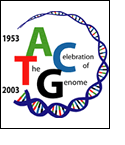Last updated: August 15, 2013
2003: Fiftieth Anniversary of Watson and Crick's Description of the Double Helix
 In April 1953, a paper appeared in the journal Nature that proposed a double helix structure for deoxyribose nucleic acid DNA. Determining the molecular structure of the gene was one of the most significant achievements in all of science. The structure was deceptively simple and immediately answered some important questions about genes and how they work. Toward the end of the short paper is a sentence that reads, "It has not escaped our notice that the specific pairing we have postulated immediately suggests a possible copying mechanism for the genetic material."
In April 1953, a paper appeared in the journal Nature that proposed a double helix structure for deoxyribose nucleic acid DNA. Determining the molecular structure of the gene was one of the most significant achievements in all of science. The structure was deceptively simple and immediately answered some important questions about genes and how they work. Toward the end of the short paper is a sentence that reads, "It has not escaped our notice that the specific pairing we have postulated immediately suggests a possible copying mechanism for the genetic material."
The model proposed by Francis Crick and James Watson resulted from nearly two years of work and was partly based on X-ray diffraction data from their colleagues Maurice Wilkins and Rosalind Franklin. Crick, Watson, and Wilkins shared the 1962 Nobel Prize in Physiology or Medicine for their work. Franklin had died in 1958 and was not included since the Nobel Foundation doesn't award posthumous prizes.
More Information
References:
Watson, J. D. & Crick, F. H. C. Molecular structure of nucleic acids: A structure for deoxyribose nucleic acid. Nature, 171: 737-738. 1953. [PubMed]
The Double Helix, J.D. Watson (1968) Atheneum, New York.
What Mad Pursuit, F.H.C. Crick (1988) Basic Books, Inc., New York.
Rosalind Franklin: The Dark Lady of DNA, B. Maddox (2002) HarperCollins, New York.
The Third Man of the Double Helix, M. Wilkins (2003) Oxford University Press, New York.
« Previous Event | Next Event »
